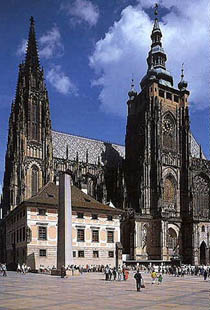
The Cathedral of Saint Vitus belongs to the Catholic Church
 |
The District Court for Prague 1 ruled today that St. Vitus Cathedral and the adjacent properties belong to the Church. However, the dispute is still ongoing after 13 years. The Office for the Representation of the State in Property Matters intends to appeal the decision again to the municipal court.
"This is a clear answer to all those who proclaimed according to communist jargon that the cathedral belongs to all the people," the Catholic primate Vlk told ČTK today. He labeled as nonsensical the views that the Church could alienate a national cultural treasure and "take it to the Vatican."
A few years ago, Vlk expressed his willingness to donate the cathedral to the nation. "The government at the time and its prime minister Václav Klaus rejected it; they wanted to solve the matter by law, which I could not accept. Today our willingness has passed," he declared.
"We are glad that the thirteen-year martyrdom is hopefully coming to an end," Cardinal Vlk noted regarding the process and the efforts of some politicians who, according to him, delayed a just solution. He reminded that a complete property settlement between the state and the Church still does not exist.
When the state assumed responsibility for church monuments after 1949, which had previously been maintained by so-called patronages of nobility or towns, it did not fulfill its duty well, according to the cardinal.
"It is fair to say that the Administration of Prague Castle has taken good care of the cathedral, at least of its outer shell. However, some things inside are damaged or lost," stated the Catholic primate. Some houses in Hradčany, which the Church also litigated over, including the famous wine cellar Vikárka, have been vacant and falling into disrepair for several years. It is evident that the Administration of Prague Castle does not need them. "They will receive better management," he remarked.
"For the behavior of the Administration of Prague Castle in some cases, I cannot find a courteous word," said the cardinal. For example, the Church had to lease the Old Provostry.
Petr Veber
St. Vitus Cathedral in the third courtyard of Prague Castle is a significant religious and political symbol of the Czech Republic. Its foundation stone was laid in the 14th century, but the cathedral took its current form only after its completion in the 19th and 20th centuries. After 1989, a dispute over its ownership erupted between the Catholic Church and the state.
The foundation stone of the cathedral was laid on November 21, 1344, in the presence of King John of Luxembourg and Archbishop of Prague Arnošt of Pardubice. Emperor Charles IV played a significant role in the development of the cathedral, inviting architect Matthäus of Arras from France. After his death in 1352, Petr Parléř continued the work.
In 1419, construction was interrupted for four centuries. The cathedral then went through an unfavorable period. For example, in June 1421, it was looted by the Hussites, and in 1541 the church burned down to its foundations. Only in 1844 was the Association for the Completion of St. Vitus Cathedral established, and work resumed. Architect Josef Mocker was commissioned to direct the cathedral's completion. He gave the building its current neo-Gothic appearance, characterized by two towers at the facade. The ceremonial opening of the still incompletely finished cathedral took place on September 28, 1929, on the occasion of the St. Wenceslas Millennium.
After World War II, the Association continued its efforts to complete the construction, but it was dissolved in 1954, and the administration of the cathedral was handed over by government decree to the Office of the President of the Republic.
Throughout its existence, the cathedral has served not only for religious ceremonies but also became a significant political center. It was the site of the coronation of Czech kings. The remains of significant Czech monarchs, nobles, and archbishops are interred in its crypt. The Czech crown jewels are also stored in the cathedral.
The English translation is powered by AI tool. Switch to Czech to view the original text source.
0 comments
add comment






